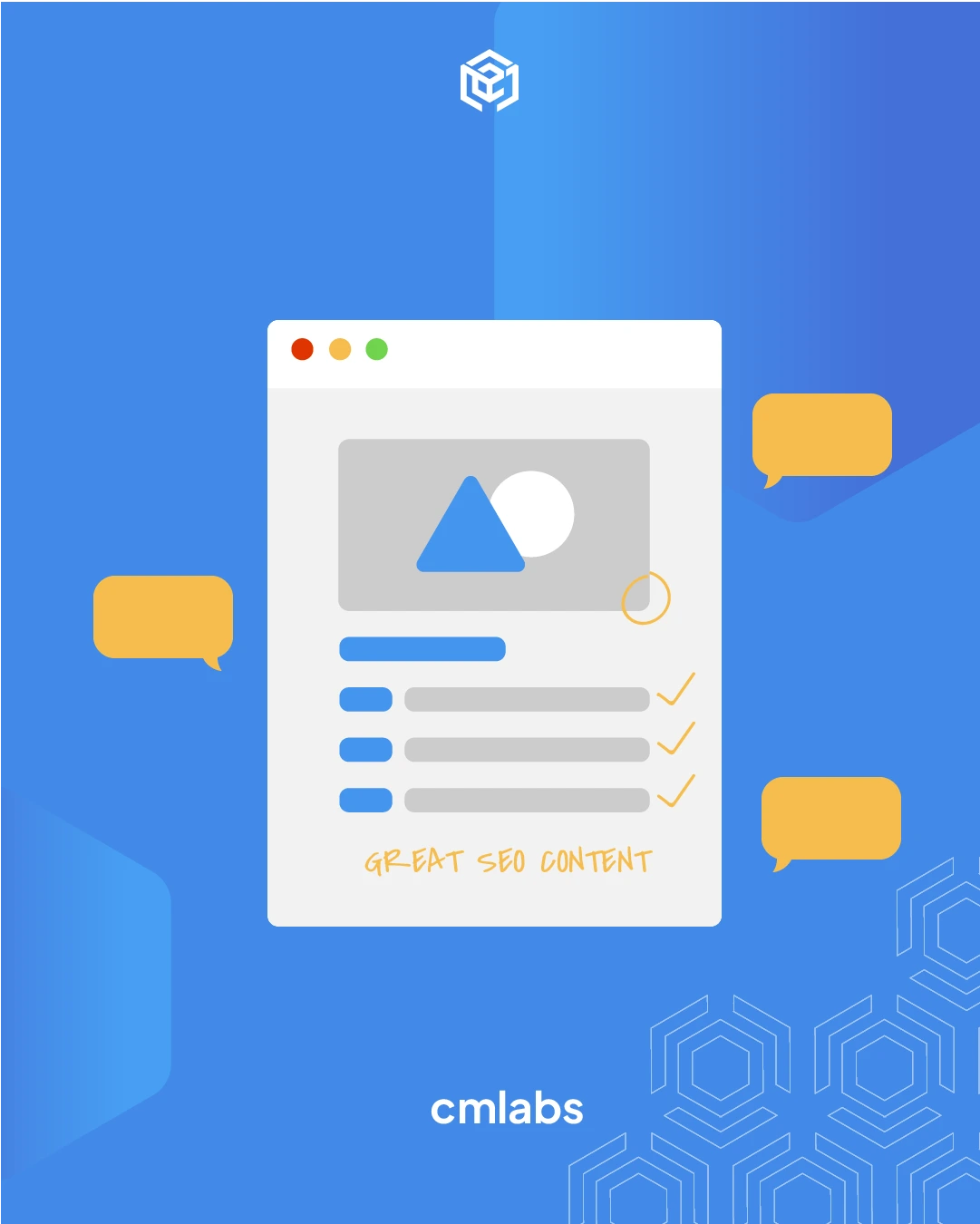We use cookies
This site uses cookies from cmlabs to deliver and enhance the quality of its services and to analyze traffic..
SEO SERVICES
Conduct in-depth technical website audits, strategically develop website projections, and increase your website authority.
ASO SERVICES
Elevate Your App’s Presence with Our Expert ASO Services – Boost Visibility and Drive Downloads!
WRITING SERVICES
We offer a variety of writing services to suit different business necessities. Reach broader audiences or lead specific industries? We've got you covered!
Get relevantly positive media exposure from bloggers and online publishers to increase your brand mentions on search engine results pages.
SEOlutions
A unified source of truth!
SEO & Digital Maternity Solution
SEO & Digital Maternity Solution: Leverage Cross-Platform Insights to Elevate Your Strategy with Expert Consultation
SEO & Digital Maternity Solution
Data Solution options:
Starting from Rp200 mio
Reinventing how a company get creative treatments
A new way to get your creative needs done. Agile team, efficient cost, and expedient way in a flexible yet scalable subscription plan!
Creative-as-a-Services
CaaS package options:
Based on Subscription
Pioneer in digital marketing software powerhouse
We’re excited to unveil our new range of Tech Solutions designed to drive your digital success. Whether you’re looking to enhance your website’s performance, streamline your tech stack, or unlock deeper insights from your data, we’ve got you covered.
Starting from Rp250 mio
Our Clients
Research and innovation center for digital transformation
Digital marketing combines technical skills and business knowledge at every stage. For marketing teams, improving budget management efficiency is crucial, as time is an invaluable resource that should be used wisely. At Sequence, we are dedicated to empowering you to optimize efficiency and strategic planning, ultimately enhancing the impact of your digital marketing efforts.
Subscription-based (IDR1,800/keyword)
Our Clients
BeyondSEO
References
SEO Tools for Webmasters
SEO Tools for Writers
SEO Tools
FIND THE SUITABLE PARTNERSHIP FOR YOUR COMPANY
Check out which cmlabs partnership program suits your company
WHITE LABEL SEO
for CorporateYour company is granted exclusive partnership rights to provide SEO services to our important clients, and we will provide a dedicated backend team to support your efforts.
AFFILIATE PROGRAM
for BizdevA new affiliate program is being introduced for skilled marketers and individuals with strong networks, offering commissions of up to 7% for generating profits independently.
DIGITAL AGENCY
for Marketing Partnerscmlabs is an essential partner for digital agencies, providing a unique selling proposition in Search Engine Optimization (SEO).
BACKLINK PARTNERSHIP
for Media / BloggerWe have a vast database of bloggers and media outlets across Indonesia, categorized by region and media type, giving our clients an edge in managing their media and SEO activities.
OFFICIAL TRAINING
We provide ongoing professional development and support to SEO professionals to ensure they are equipped to meet market demands.
JOIN AS CONTRIBUTOR
for Content WriterGreat opportunity for SEO Writers around the world. T&C applied!
ACADEMIC PARTNERSHIP
Through partnerships with universities in Indonesia, cmlabs has helped align academic curricula with industry demands.
Partnership
Sector & Industries
Tell us your SEO needs, our marketing team will help you find the best solution
As an alternative, you can schedule a conference call with our team
Schedule a Meeting?Contact
Survey
We use cookies
This site uses cookies from cmlabs to deliver and enhance the quality of its services and to analyze traffic..
Last updated: Feb 13, 2025

A prototype is an initial model or example of a product, system, or project. If you wonder “what is prototype”, this model is specifically designed to illustrate the appearance and functionality of the product.
Prototypes are often used in the design and development process to test and identify features, functions, and the product's design before the production process.
Through this model, you can gather feedback and evaluations from users, clients, or stakeholders to ensure that the product is created according to the desired expectations and needs.
The purpose of creating prototypes is to provide a visual or functional representation of the product being developed before its final version is completed.
During the product development process, users can participate in evaluations and provide feedback.
The feedback provided will serve as a reference in the product development phase. Furthermore, this action can also generate new ideas that can be developed into features to enhance the product.
One essential element in the product development process is having a sample model. Through this model, you can test ideas, concepts, and designs before fully developing the product.
Becoming one of the most crucial steps in the product development process, its existence offers several benefits. Here's a detailed explanation:
Utilizing prototypes offers long-term advantages by streamlining the product development timeline and cutting costs.
Early integration of this model in the initial phases allows for swift detection and rectification of potential glitches and flaws, paving the way for enhanced iterations prior to advancing product development.
It significantly diminishes the probability of substantial alterations in the conclusive phases of product development.
This is particularly valuable as these later stages frequently demand a considerable investment of time and valuable resources.
Having a sample product can actually facilitate direct user testing of the product which can accordingly foster valuable interactions.
Engaging with this model empowers users to offer insights into coveted features, and functionalities, and pinpoint issues that warrant attention.
Such insights play a pivotal role in enhancing stakeholders' comprehension of user requirements, subsequently guiding the development of a product that aligns more closely with user expectations.
With a clear and detailed model or design, you can have a visual guide to follow in the product development process.
This clarity equips stakeholders with the ability to recognize any deficiencies within the product, thereby prompting a concerted effort to explore holistic enhancements and remedies.
Presenting a well-designed and interactive prototype can help communicate ideas more clearly and effectively.
This makes it easier for you to explain product concepts and designs to users, clients, and stakeholders.
In addition to understanding “what is prototype” as well as its benefits, you also need to comprehend the common types of prototypes used in the product development process:
Here are some types of prototypes that you probably see in daily life::
Sketch and diagram prototypes encompass rough sketches and drawings, as the name implies.
Despite their simplistic nature, these models play a pivotal role in swiftly and effectively conceptualizing ideas and concepts.
This type can provide a solid foundation before delving into the intricacies of advanced development phases.
You must be familiar with the concept of 3D printing. This variety presents a tangible three-dimensional representation of the evolving product or component.
By employing such a model/sample, enterprises can expedite the shift from design to production, thanks to the streamlined identification procedure.
Upon finalizing the identification phase, a mere digital reprogramming is required to proceed.
If you wish to gain tangible insight into the product under development and attain a deeper visual perspective, the physical model is the solution.
The physical model is created using physical materials such as paper, cardboard, or other substances.
This type works effectively in conceptualizing on a small scale before advancing to the production stage.
A wireframe is one of the most commonly used prototypes for websites, software, or other digital tools.
Wireframe focuses on the user interface (UI) appearance and design. As a result, it usually contains the fundamental framework of UI elements without intricate visual design details.
Through this model, you can design an efficient and user-friendly UI structure and layout.
The additional category is known as feasibility prototyping. This approach is frequently employed to assess the viability of a particular product or system.
In pursuit of this goal, feasibility prototyping delves into the realms of product functionality and performance, while also appraising the probability of effectively materializing a given idea or product concept.
Now, you have understood the definition, benefits, and types of it. However, in order to master this concept better, let’s get to know some of the examples of it, listed in the followings:
As the name suggests, this type of prototype employs paper as its medium. Despite its simple form, a paper model design can provide insights into both the visual appearance and functionality of a product.
Some of the examples include hand-drawn sketches, diagrams, or images representing user interface (UI) visuals or product layouts.
A low-fidelity sample tends to nearly resemble a product but with lower levels of detail and resolution.
Examples of this model can be seen in wireframes or digital mockups that depict product designs without complete visual details.
On the other end of the spectrum lies high-fidelity prototyping, where the sample bears a remarkable likeness to the ultimate product.
Engaging with a high-fidelity sample engenders a sense of the final product's encounter.
Nevertheless, it is imperative to acknowledge that the development of such prototypes is an endeavor marked by temporal investment and financial allocation.
You can see some examples of high-fidelity prototypes in applications that are still in development but already look like the actual final application.
WDYT, you like my article?
Couldn't find result for "Mulki" try to search with different keyword
Suggestion:
Tell us your SEO needs, our marketing team will help you find the best solution
As an alternative, you can schedule a conference call with our team
Schedule a Meeting?



cmlabs Jakarta Jl. Pluit Kencana Raya No.63, Pluit, Penjaringan, Jakarta Utara, DKI Jakarta, 14450, Indonesia
(+62) 21-666-04470These strategic alliances allow us to offer our clients a wider range of SEO innovative solutions and exceptional service.

Psst! Hey there, SEO Stats and Tools SEO company! If you've ever planned of conquering the Indonesia market, you've come to the right place!